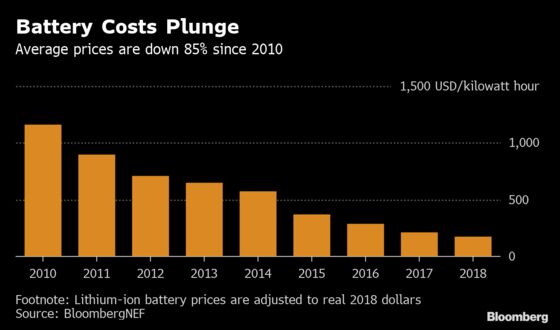Cheap Gas Is Killing Nuclear, Green Power May Finish the Job
Cheap Gas Is Killing Nuclear, Green Power May Finish the Job
(Bloomberg) -- The natural gas boom is killing America’s nuclear industry. Wind and solar may finish the job.
While nuclear plants struggle to compete with the flood of cheap gas coming from the nation’s shale fields, they still offer a key advantage, supporters say: They generate 24-hour electricity without producing carbon emissions. Renewables, meanwhile, haven’t yet nailed down the storage capacity needed to do that. Proponents insist it’s only a matter of time.
Battery prices have plunged 85% from 2010 through 2018, and huge storage plants are planned in California and Arizona. Meanwhile, science is advancing on new technology -- including chemical alternatives to lithium-ion systems -- with the potential to supply power for 100 hours straight, sun or no sun.
“All signs point to the acceleration of renewable energy that can out-compete nuclear and fossil fuels,” said Jodie Van Horn, director of the Sierra Club’s Ready for 100 campaign, a group seeking a grid powered solely by renewables.
The drive for grids that are 100% emissions-free is being pushed by a growing number of U.S. states citing increasingly aggressive time frames. In July, New York mandated that 70% of the state’s power come from renewables by 2030, and 100% by 2040. Seven other states, including California, have similar mandates, and Virginia’s governor earlier this month announced an executive order calling for 100% clean energy there by 2050.

Still, there remains a gap between now and 2050. “To get to 80%-to-85%, you can see a path to get there with today’s technologies,” said Yayoi Sekine, an analyst with BloombergNEF. But using renewables to achieve the final 15%, “that’s where the challenge really is.”
By 2050, BNEF expects renewables to account for 48% of the U.S. power system, paired with multiple types of supplemental, peaking plants that can supply electricity when needed.
Today, these plants typically burn cheap gas, supplied by a muscled-up U.S. shale industry. By 2035, though, so-called battery peakers -- large arrays that store energy when renewables are working at their peak, and send power when they’re not -- will be more cost-competitive, according to BNEF forecasts. Meanwhile, over the same period, nuclear will wane, as high costs force most reactors to just shut down.
The U.S. isn’t the only place where the nuclear industry is struggling. Some nations that rely heavily on the technology, including France and Sweden, are reducing nuclear’s load as old reactors retire, and diversifying into cheaper solar and wind power.
Still, the industry has the potential to grow in countries where costs can be reduced through shorter construction times. Engineers in China have been able to build and connect nuclear plants in less than seven years, on average, while their counterparts in the U.S. and Europe need a decade or more.

Meanwhile, the U.S. Energy Department’s top nuclear official says reactors will play a prominent role in the power mix, and the agency is talking to countries interested in deploying smaller, modular reactors now being developed at lower costs.
“If any country or state is looking to meet their carbon goals, then nuclear energy has to be an absolute part of the solution,” Assistant Secretary Rita Baranwal said in an interview.
In the U.S., the utility scale storage plants being developed by AES Corp. in California and Arizona will have 100 megawatts of capacity when they’re expected to be completed in 2020 and 2021, respectively. And New York’s biggest battery system was just switched on, a 20-megawatt facility that’s part of the state’s plan for a 100% green grid.
But there remains “a lot of uncertainty about how technology will evolve” between now and the ultimate goals set by states like New York, said Carl Mas, the director of energy and environmental analysis at New York State Energy Research & Development Authority. “Beyond 2030, it’s an open landscape.”

It’s that bit of uncertainty that nuclear supporters tend to grab on to, at a time when the nuclear industry is developing its own cheaper alternatives. These include the modular reactors that are cheaper and more flexible than the large power plants common today, or molten-salt systems that are safer and produce less waste.
Still, these options are far down the road. The first modular reactors in the U.S. aren’t set to go into service until 2026, and the salt technologies are still largely in the research stage. At the same time, installed capacity of nuclear in the U.S. is forecast to fall to 6 gigawatts by 2050, down from 101 gigawatts now, according to BloombergNEF.

The Nuclear Energy Institute, the industry’s main trade group in the U.S., supports wider use of wind and solar power, but Matt Wald, a spokesman, is skeptical that storage technologies will advance to the point where people will be able to “watch TV at night using midday solar.”
Batteries are “cost-effective in many roles, but bulk storage is not one of them,” Wald said.
The Sierra Club’s Van Horn, not surprisingly, disagrees. “It’s not enough to be carbon-free,” she said. “It has to be safe and clean.”
This story is part of Covering Climate Now, a global collaboration of more than 250 news outlets to highlight climate change.
(Michael R. Bloomberg, the founder and majority stakeholder of Bloomberg LP, the parent company of Bloomberg News, has committed $500 million to launch Beyond Carbon, a campaign aimed at closing the remaining coal-powered plants in the U.S. by 2030 and slowing the construction of new gas plants.)
--With assistance from Jonathan Tirone and Hannah Recht.
To contact the editor responsible for this story: Reg Gale at rgale5@bloomberg.net, Joe Ryan
©2019 Bloomberg L.P.